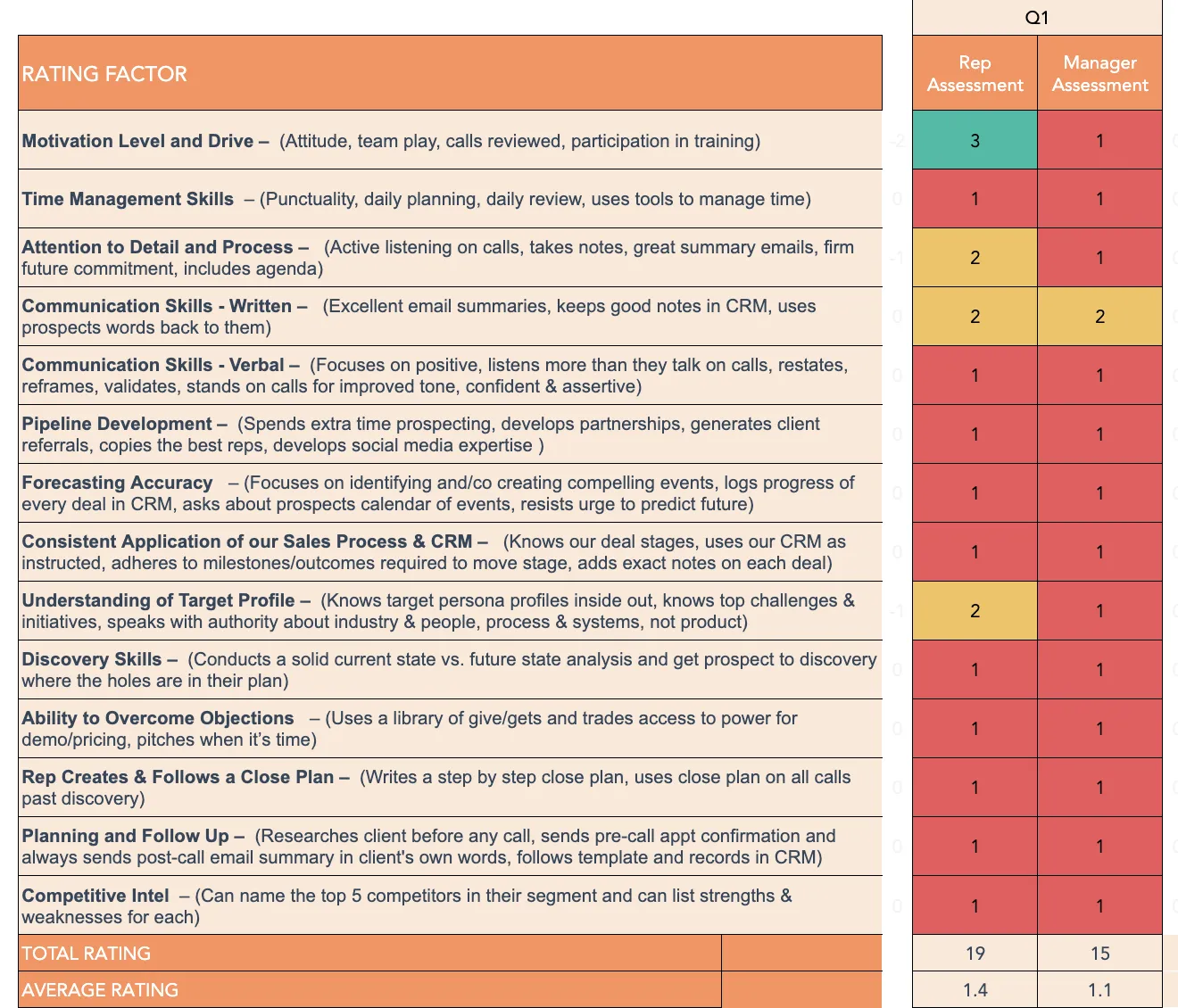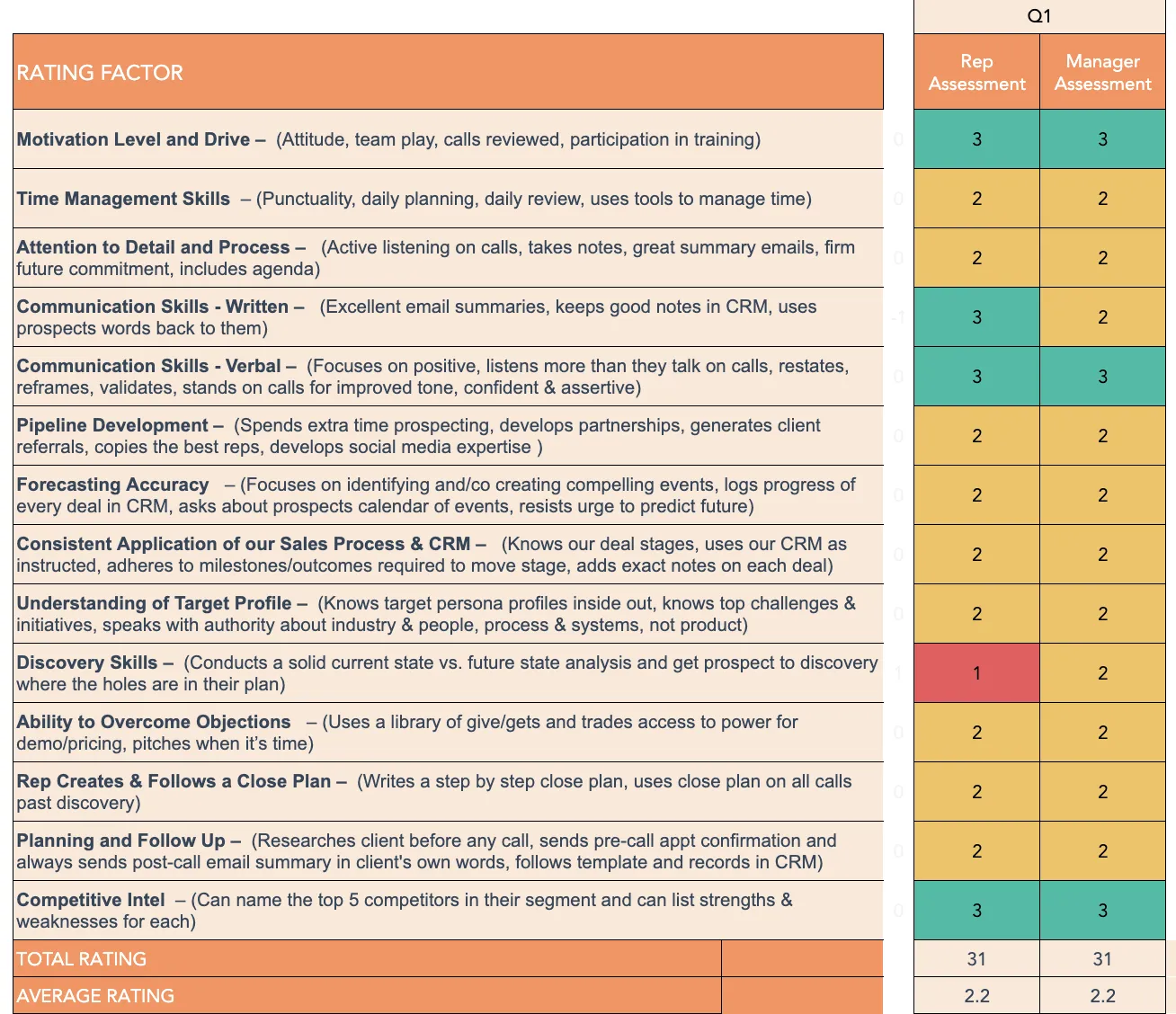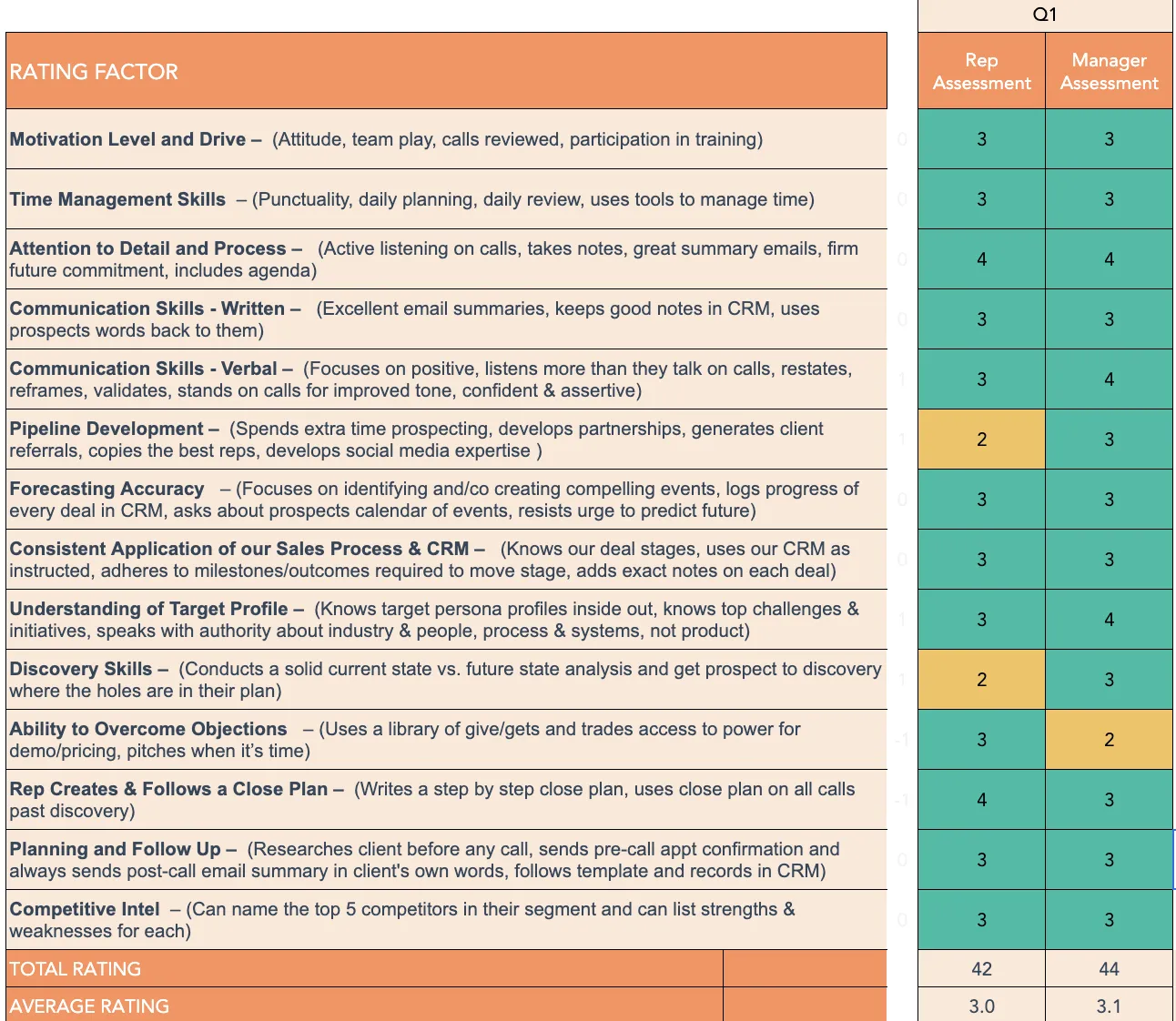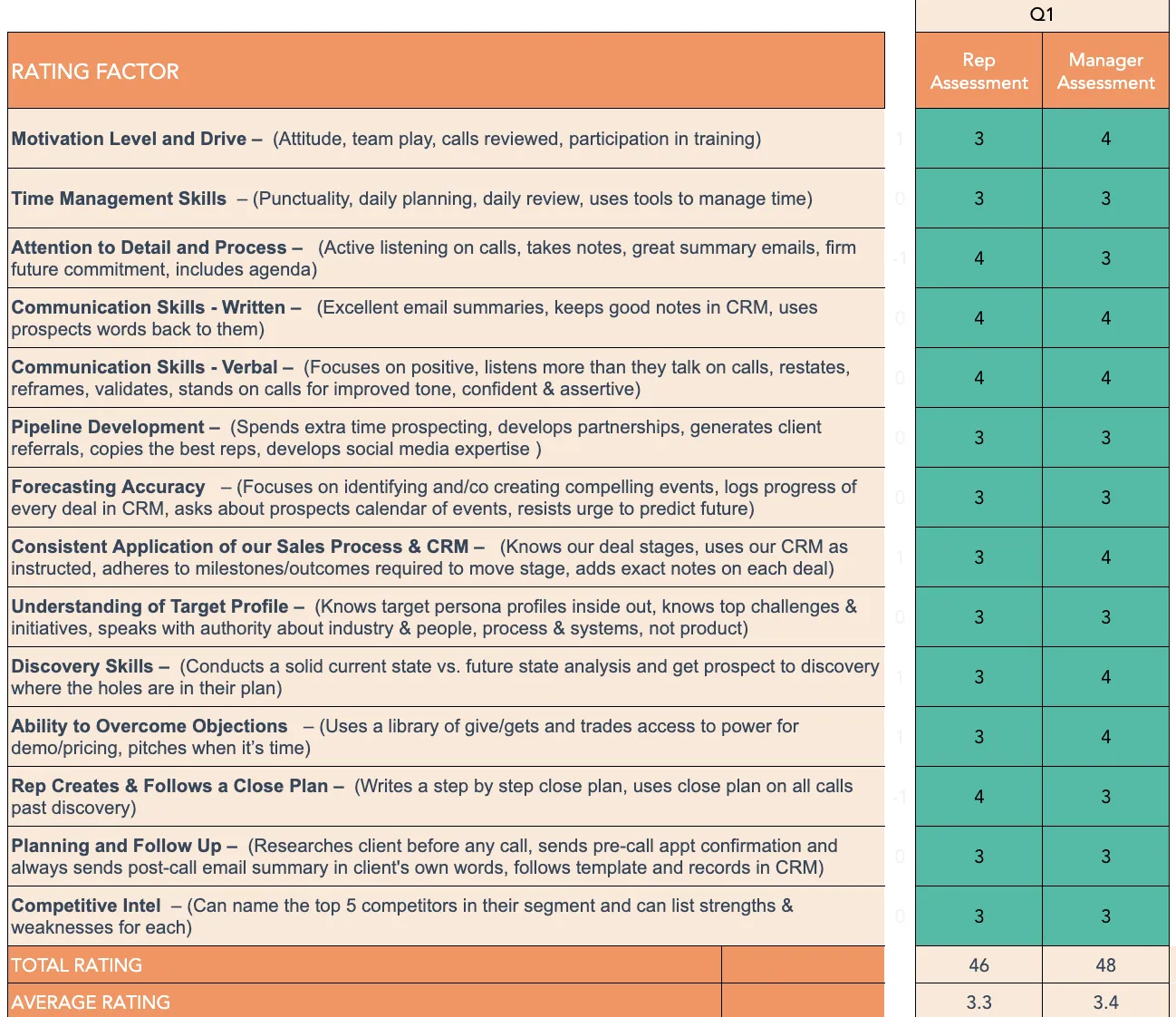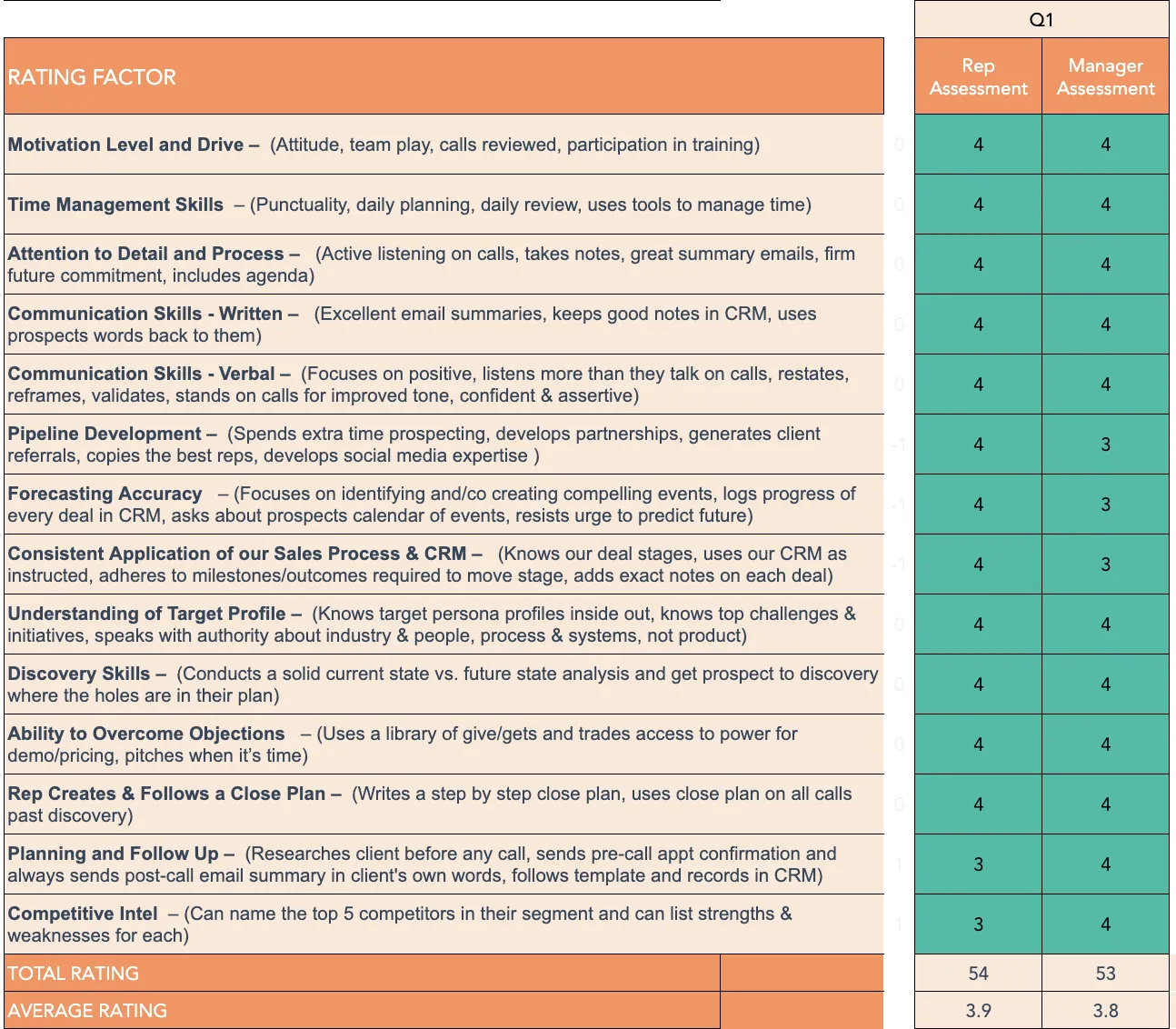- Sales Performance Review
- Why a Sales Performance Evaluation Is Important
- How to Lead a Sales Associate Performance Review
- Sales Performance Review Examples
- Sales Performance Review Self-Assessment Examples
- Sales Performance Evaluation Template
My Experience Assessing Sales Performance
Over ten years as a quota-carrying, customer-facing sales professional, I worked with some great sales managers. The ones who motivated me best encouraged me to spend as much time as possible with prospects, partners, and customers. They inspired me to work transparently by documenting my activities in the company CRM application.
Mike was the manager who inspired my best results. He was the head coach of a local university hockey team. He played hockey before coaching and sold software before managing.
Mike approached business and sports team leadership with a similar mindset. He built strong, trusting relationships with his team by identifying strengths, and capitalizing on them. He could recognize weaknesses and mentor reps on improving their skills.
Sales cadence meetings with Mike weren’t stressful and had few surprises. Our sales team had an “if it isn’t documented in CRM, it never happened” policy. He could easily track opportunities and monitor activities like calls, emails, and meetings.
Why a Sales Performance Evaluation Is Important
According to 2022 Gallup research, only 21% of employees are engaged at work. Low engagement has an estimated cost of $7.8 trillion for the global economy. Engagement can also impact performance outcomes.
Sales performance reviews give leaders a chance to challenge and strengthen the team. We surveyed 1,400 sales reps and found that a culture of trust, collaboration, and transparent performance data are the top factors separating high-performing sales teams from underperforming ones. You need all of these elements for an engaged sales team, which leads to:
- Efficiency
- Effectiveness
- Performance
Giving a better performance evaluation is a skill you should aspire to and can reach. Gallup’s State of the Global Workforce 2023 report found that 70% of team engagement is attributable to the manager. When provided with training, managers’ team engagement rose as high as 18% in the following 18 months, which impacts performance.
Lay a Foundation for Growth
Good performance evaluations don’t happen in a vacuum. Let’s take a look at the foundation you need before you can enter a successful performance evaluation.
1. Set a clear roadmap
Sales teams need a clear roadmap of the core competencies and performance goals needed to advance within your company. Beyond a skills assessment, they should have a big-picture vision of where they are, where they’re heading, and what they need to get there.
This doesn’t need to look the same for every company. Michael Maximoff, founder and managing partner at lead gen agency Belkins describes his team's seven-level sales career ladder for assessments and advancement.
“We call this ladder a competency ladder, and it measures not just their performance in terms of how much revenue they generated or how they closed their KPI, but also the impact of them on the company. This ladder is shared with every sales executive so they have access to it so they can see where they are,” Maximoff says.
When a professional can see how their actions will contribute to their long-term personal and professional goals, it motivates them to take action and improve.
2. Build a culture of collaboration and feedback
An annual performance review shouldn’t be the only time you give substantial feedback and coaching, and it shouldn’t contain any surprises. Use team standups, one-on-one meetings, and sales ride-along calls to give continual feedback. This makes performance reviews much easier since it won’t be your first time discussing these topics.
3. Establish trust
For a performance evaluation to be successful, you need a foundation of trust between the sales manager and the sales rep. Our State of Sales study found that 24% of high-performing sales teams prioritize building a culture of trust in their sales team, compared with 13% of underperforming teams.
“The person who gives that feedback in a performance review should have credibility to give fair, constructive feedback. I need to have confidence that the person who gives me that feedback knows what that person is doing. Right? But for that to happen, you need to have some kind of relationship and context with that individual,” says Maximoff.
How to Lead a Sales Associate Performance Review
1. Use a sales performance evaluation template
To set yourself up for success, you need a document outlining the areas of discussion for your sales performance evaluation, and which specific competencies you will review. You can create your own or use a template to do the initial hard work for you.
We’re sharing our HubSpot Sales Performance Review Template with you so you can access and implement a framework for improving sales performance, one review at a time. Download the template, make any adjustments you need to to fit your organization, and use the template consistently across your team.
2. Prepare for sales performance reviews
It's tempting to jump into a performance review with your thoughts and impressions. But these are complex conversations that can have long-term impacts. So, do some preparation before every review.
Analyze current roles and responsibilities
Your company may have useful forms or job descriptions that you can use as a starting point for your review. If one of your salespeople has taken on extra tasks or responsibilities, be sure to add those in.
Complete a written review on your own. List out strengths and areas for improvement based on the job description. Then, add any other observations you have to add about sales training or performance. Remember, measurable specifics are more useful than general observations.
Get self-assessments from the sales team
Next, ask each member of your sales team to write a self-assessment. Set clear expectations for self-assessments.
Offer a short and simple set of questions to cover:
- Day-to-day tasks, like managing a sales pipeline
- Sales goals, like deals closed and won
- Other opportunities, like working on cross-departmental projects
It‘s also useful to ask them about how they feel they’re performing and where they feel they can improve.
Be sure to offer examples that can help guide salespeople who are evaluating themselves for the first time.
Collect feedback from stakeholders
Another way to prepare for sales reviews is to gather feedback from other employees. You can collect their insights with casual conversations, email, or online chat.
If it fits your company culture, online surveys can also help you gather insights on performance. Be sure to ask clear and specific questions to get the best feedback.
Prepare your performance evaluation document and talking points
Once you have the information you need, put your key points in writing. This may seem like an extra step, but putting your review on paper before the review can help you remember key details during your conversation.
Your completed performance reviews might include:
- Examples to support your feedback
- Quotes from the self-assessment or stakeholders
- An outline of SMART goals to work on
If the review is a challenging one, this step can also help you give a positive and learning-centered tone to critical feedback.
Ideally, there won't be any surprises in the review for members of your sales team. This means that each review can focus on how to improve in the future.
3. Begin each review with job expectations
Starting performance review talks can be awkward sometimes. So, instead of starting with what went well and what needs work, set expectations. Beginning with the job description can lessen the stress and confusion that can come up during reviews.
Another strategy is to talk about career ladders in your company or department. This can help each sales associate understand where they fit and how they can improve.
Make each sales review a learning opportunity
As you start the review, be sure to highlight that reviews are a chance for both of you to grow. The focus is often on the feedback that you are offering to each salesperson as their manager.
But it's also important to share that you are also collecting feedback that can help you improve processes and strategy.
This is a positive experience where everyone gets something valuable. Be sure to set that tone from the start and each review should go smoothly. If you're looking for tips on how to get the most from a review, this podcast from Gallup has some useful tips.
4. Discuss sales performance
Once you‘ve covered expectations and set a positive mood, it’s time to dig into the sales performance review.
You're already offering consistent feedback. So, this time should offer each salesperson useful and specific feedback and learning.
Review sales performance metrics
Use data to back up your performance discussion as a starting point. Each review should cover metrics within a set time period, so you may want to compare this review period's numbers to the previous period or against the company average. Typically, sales teams monitor repsales metrics including:
- Call volume
- Number of new leads or opportunities
- Average win rate
- Average close rate
- Number of deals closed
- Deal slip rate
- Sales cycle length
- Upsell and cross-sell rates
- Average deal size
- Quote attainment
What Went Well
Moving beyond data to analysis, start with what they‘re good at. Take the time to call out how they’ve mastered different processes and how they make the most of opportunities.
For example, don't just compliment salespeople on their ability to meet call volume. Instead, share that you notice blockers that they move past to make those calls, like doing extra research to find a working number for a lead.
Positive Sales Performance Review Phrase Examples
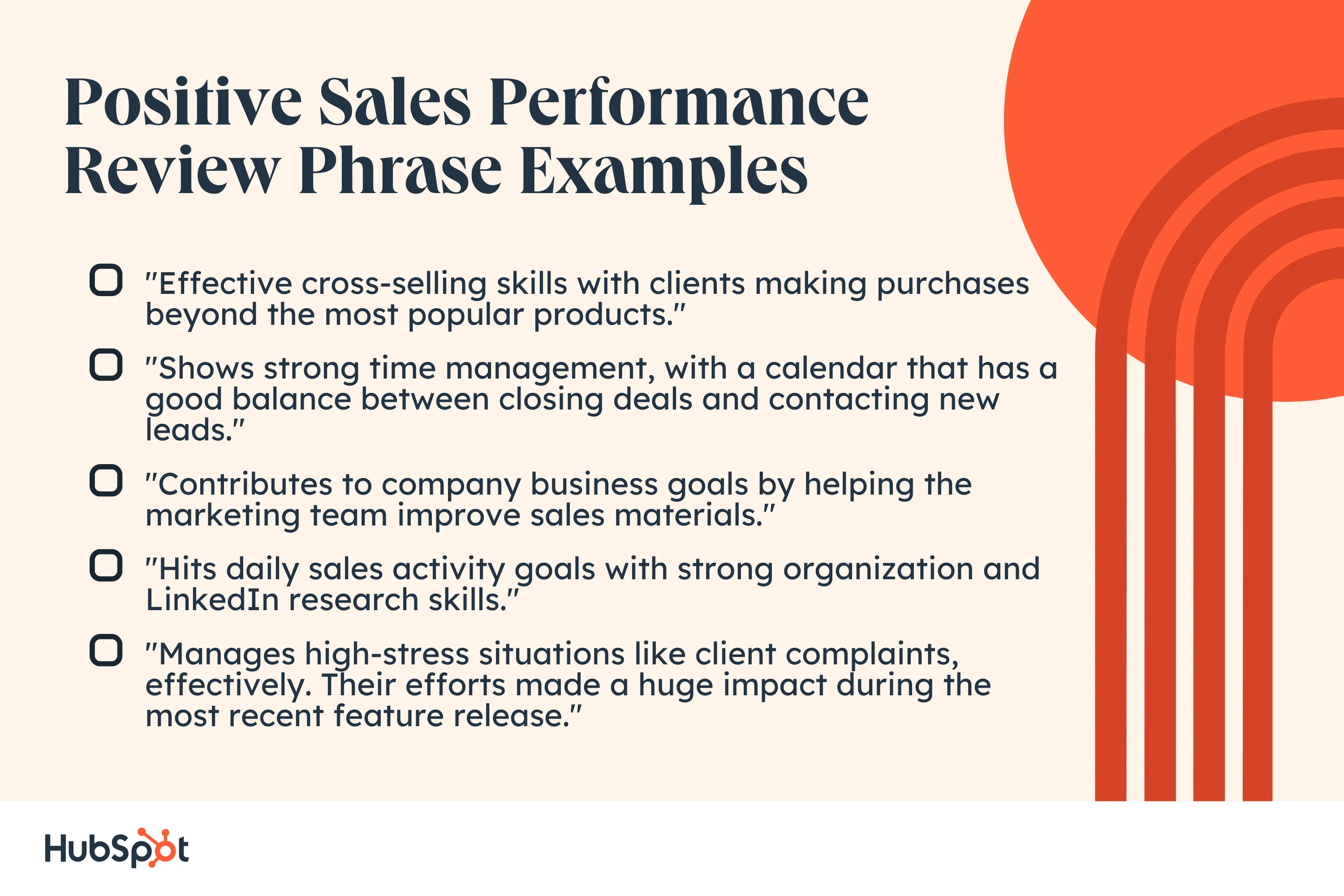
- “Effective cross-selling skills with clients making purchases beyond the most popular products.”
- “Shows strong time management, with a calendar that has a good balance between closing deals and contacting new leads.”
- “Contributes to company business goals by helping the marketing team improve sales materials.”
- “Hits daily sales activity goals with strong organization and LinkedIn research skills.”
- “Manages high-stress situations like client complaints, effectively. Their efforts made a huge impact during the most recent feature release.”
These performance review example phrases show appreciation for sales skills. They also outline the specific ways the salesperson is putting those skills into action. This helps them understand what they are doing right and inspires them to continue those habits in the future.
What Needs Improvement
Once they understand the value they‘re bringing to their role, it’s time to engage your salespeople with areas for improvement. It's best to approach these areas from a goal-setting perspective.
Being objective can help shift the conversation away from personal critique and toward working together to improve. You might also find value in connecting each area for improvement to a team or company priority.
For example, say a member of your sales team often shows up late to team meetings. If one of your team values is respect, you can talk about how tardiness in general is disrespectful to the team.
Another strategy is to approach areas for improvement as questions. For example, asking “Which listening skills are you best at, and which could you improve?” gives a sales rep a chance to share where they excel. It also gives them a chance to let you know whether you both see an area where they could improve.
Negative Performance Review Phrase Examples
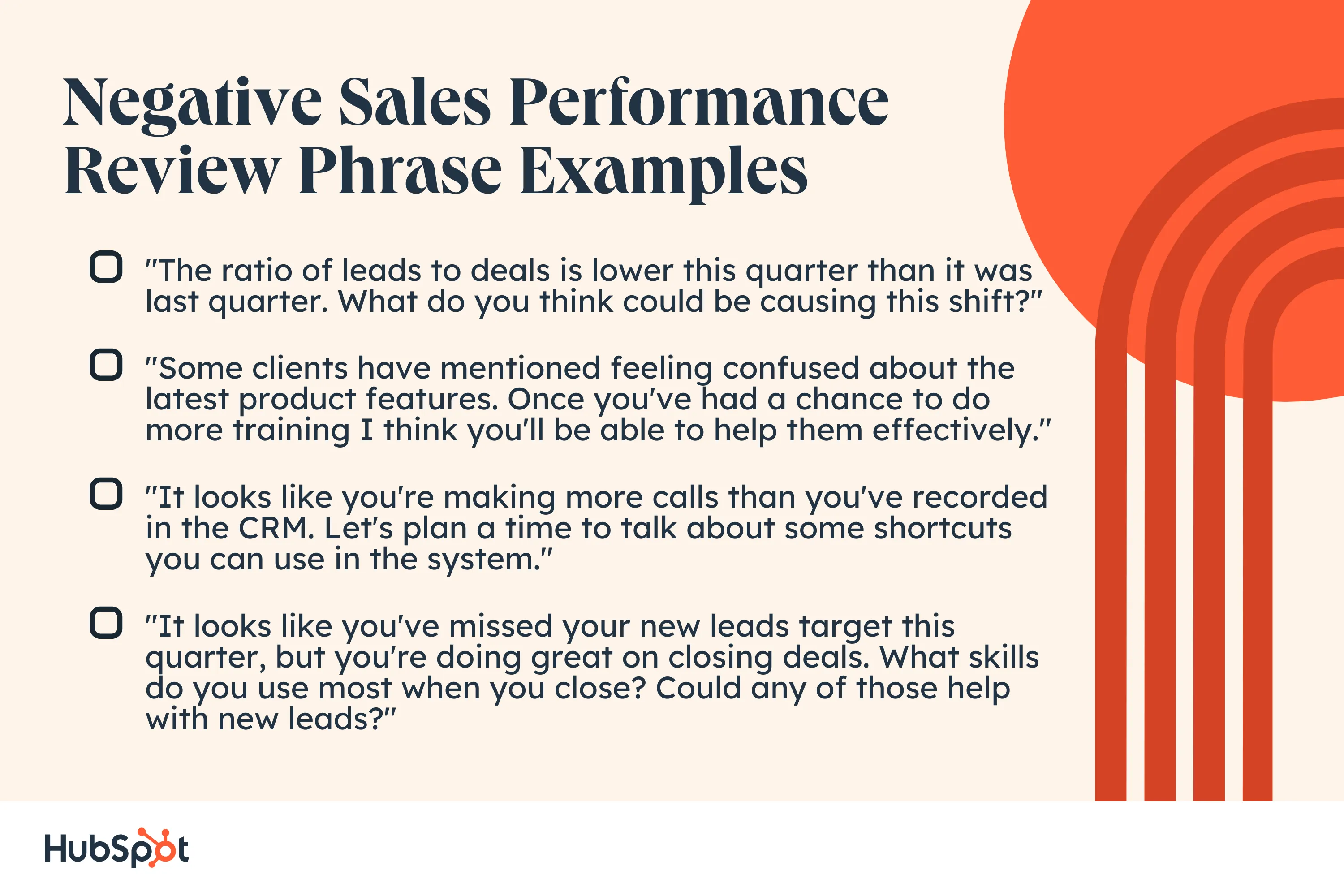
- “The ratio of leads to deals is lower this quarter than it was last quarter. What do you think could be causing this shift?”
- “Some clients have mentioned feeling confused about the latest product features. Once you've had a chance to do more training I think you'll be able to help them effectively.”
- “It looks like you're making more calls than you've recorded in the CRM. Let's plan a time to talk about some shortcuts you can use in the system.”
- “It looks like you've missed your new leads target this quarter, but you're doing great on closing deals. What skills do you use most when you close? Could any of those help with new leads?”
- “I know that upselling in this industry can be tough. I had a hard time with it until I learned this tip from my mentor.”
- “It was tough when that client changed their mind at the last minute. The same thing happened to me a couple of years ago. This is what I took away from the experience.”
Finish your feedback on a positive note
Sales performance reviews can be mentally and emotionally taxing. Instead of moving right into future planning, make sure to close the review with more positive feedback. Show your salespeople how their work supports the company and the team.
If you have a mission-driven organization, talk about how their individual work supports that vision. Show them how they're making an impact with their role. Make it clear that there is a community that values their work.
5. Review sales evaluation outcomes and learning
Finally, close out each sales performance review by making a plan for what needs to happen next. Whether you're recommending business coaching or an improvement plan, that work should begin right away.
Create an improvement plan
If you talked about specific improvement in soft skills or metrics, set a date to follow up and measure progress. If the goals you discussed were more open-ended, ask them to create some SMART goals around those ideas. If you don’t have a lot of experience with this type of goal-setting, this SMART template can help. Then, set a time to check in.
How CRMs Help with Sales Evaluations
Even though documenting activities and capturing conversations in the corporate CRM application could be time-consuming, it made forecast meetings less stressful — and more productive. It helped with sales funnel continuity, scheduling, and getting support from product managers and other teams.
I often worked with public sector organizations that required formal proposals for high-value transactions and detailed quotes for add-on sales or services. These documents required multiple rounds of revisions and sign-offs, so providing management with easy access to proposal files saved time overall.
Sales Performance Monitoring Metrics
Aside from documenting customer and prospect interactions, sales teams I worked for designated events (like determining BANT qualifications, conducting demos, or submitting a proposal) that progressed opportunities to the next sales stage.
When opportunities would get stuck in a sales stage, my manager proactively offered their help to eliminate blockers.
The sales leadership teams I worked on closely monitored on:
- Lead and opportunity quality.
- Closed revenue and quota attainment.
- Pipeline volume, usually ranging between 3 to 5 times my quota.
- Pipeline velocity and sales cycle length.
- Average deal value.
- Sales activity productivity.
- Win rates and lead-to-customer conversion rates.
- Upsell and cross-sell revenue.
Our team was measured on qualitative and quantitative sales metrics. Since I sold to government organizations, my performance metrics were unique. My opportunities often involved complex RFPs, and government employees aren’t fans of cold calls.
Developing a Culture of Accountability and Transparency
In high-performance sales organizations, transparency drives accountability and trust between salespeople and their managers. Sales automation and enablement tools like CRM (when used effectively) make communication easy. Sellers can keep their colleagues and managers in the loop about how their opportunities are progressing.
Transparency helps managers provide their team with needed resources, like:
- Marketing assets for products and services prospects are interested in.
- Deal support from colleagues from departments like product management, finance and legal.
- Customer service escalations for existing customers if renewals hang in the balance.
I was accountable for customer satisfaction, prospect responsiveness, and partner support in my sales roles. Post-sales friction, like last-minute credit concerns, was rarely an issue because managers had visibility into my activities.
Personalized coaching and performance improvement
In my first sales role, I had the opportunity to attend solution-selling workshops reserved for top performers. Through regular meetings and performance one-on-ones, my manager recognized my enthusiasm for selling. She coached me on pursuing my short and long-term career goals. She also gave me the tools to navigate challenging customer circumstances.
Later on, I mentored new hires and other employees joining our team.
I had a few uncomfortable one-on-one meetings with my sales managers when I wasn’t fully prepared. Yet when I documented my activities, goals, and deal progress in CRM, we could focus more on growing my career. My efforts to meet my sales goals, like quota, were easily shared.
Integrating Sales Performance Management With Overall Business Growth
Every sales team has top performers, up-and-comers, newbies, and underperformers. Monitoring how all of these salespeople perform over time helped my sales managers identify:
- Which sellers deserved promotions or raises.
- If the team needed incentive programs or adjusted quota milestones.
- When a former top performer might need counseling if their performance suddenly dips.
- Whether product training, territory realignment, or other tactics are required.
Every new calendar or fiscal year offers sales professionals the opportunity to set fresh goals. Monitoring quantitative metrics like revenue attainment, average sale value, and pipeline is crucial. Yet sales managers should also monitor communication skills and selling techniques.
Sales Performance Evaluation Examples
Need to see a sales performance review in action? These review examples help any sales manager write performance reviews supported by a numerical score. This can help you explain what each sales rep is doing well and what they can improve.
Does Not Meet Expectations
Download this Template for Free
This sales rep has low-scoring reviews on most rating factors, resulting in average ratings beneath two. This shows that they’re not meeting the expectations of their position. It might also be an indicator that the employee needs more support.
“Rep seems to be struggling to grasp and adapt to the requirements and expectations of their role. They need further training and mentoring support to help them build up their skills and capabilities.”
As you complete performance reviews for performance that doesn't meet expectations, consider what habits and challenges are impacting their performance.
Use these phrases to communicate why they're receiving a rating of “Does not meet expectations.”
- “Has a hard time communicating the core product offerings of the company”
- “Conducts little or no research on a prospect before a call”
- “Adds limited data or insights in the CRM”
- “Does not show interest in practicing to improve their presentation skills”
Needs Improvement
Download this Template for Free
The review above shows ratings with an average above two and lower than three points. This is an employee with sales performance that has room for improvement.
“There is room for improvement to meet the requirements of this role. We are making a plan to invest in training exercises to help make sure their work meets our high standard.”
This sales rep might be close to meeting expectations but still has some aspects of their job that they need to work on. Maybe they‘re a new rep who’s close to hitting their quota but is just shy each month. Or they're a more tenured rep struggling to apply a new sales approach to their workflow.
Identifying these areas for improvement in the performance review will give points to work on during any coaching or training after the performance review.
These phrases can help you communicate a need for growth while motivating your team:
- “Overcoming objections is a challenge in sales. Let's revisit the company's techniques for this skill.”
- “Develop confidence for negotiations by practicing independently and during team sessions.”
- “Test other sales strategies, not just discounts, to close a sale. Discounting can mean lower margins and strategies like storytelling can be more effective.”
- “Your prospecting and presentation skills are improving. Keep working on projection and urgency.”
Meets Expectations
Download this Template for Free
This sales performance review is for a rep with an average rating above three and lower than four. This means they are performing their job as outlined in their job description. They are meeting their quota but not going beyond those expectations.
“Rep has successfully executed their deliverables on a consistent basis, demonstrating their time management and trustworthiness.”
This employee checks all the boxes and consistently performs at or above the expected performance level. They consistently hit their goals each month.
Here are some positive phrases you can use to let them know they're doing an excellent job:
- “Sets reasonable goals and hits those goals each month. Is up-front about blockers and removes them before they impact performance.”
- “Takes extra care to understand the prospect's challenges and priorities fully and offers them a holistic solution.”
- “Consistently meets their sales goals with enthusiasm.”
- “Enters prospect and deal information into the CRM on time and includes thorough notes so the deal's status is clear to the team and management.”
Occasionally Exceeds Expectations
Download this Template for Free
In the review above, the average rating is between three and three and a half. This means the sales rep is occasionally exceeding expectations. They‘ve gone past their quota and are showing that they’re responsible and can tackle more tasks.
“Rep has demonstrated the value they add to the team. They go above expectations in all aspects of job performance by proactively seeking opportunities to grow and learn new skills.”
A rep might be exceeding quota more and more often. But at the same time, they may fall short of your top performers and don't yet have the confidence to be a leader on the team. This individual has a lot of potential and needs some coaching to perform even better:
- “Rep's performance was X% above the target [X period, quarter].”
- “Exceeded goal X out of X sales by X% by conducting original research to add to client presentations, closing X deals.”
- “Shows initiative and is eager to learn and apply new sales techniques, like using social media to find new leads.”
Consistently Exceeds Expectations
Download this Template for Free
The review above shows an average rating beyond three and a half for all ranking factors. This sales rep is consistently exceeding expectations.
As a manager, it's important to recognize top performers and to review them for a merit-based raise, incentive, or promotion.
“Rep has responded admirably to changing and sometimes challenging situations, always showing adaptability and problem-solving skills even under rigid deadlines. Their attention to detail and work are at an exceptional standard. Rep is a strong team player and brings energy and innovative thinking to the table.”
Sales associates who exceed expectations go above and beyond the requirements of their day-to-day role. They might take on extra projects, train other reps, or tackle their team's salesreporting.
If your rep consistently exceeds expectations, give clear feedback so they know they're doing outstanding work.
- “Introduced a new approach for pipeline management that was X% more effective than the previous process.”
- “Goes above and beyond to handle objections and offer value on each call by creating spreadsheets with key client details.”
- “Is a leader on the team and helps fellow sales reps with call shadowing and feedback sessions.”
- “Consistently exceeds their quota, and was X% above the target in [X period, quarter].”
Sales Performance Review Self-Assessment Examples
As mentioned above, it’s a good idea to have each sales rep write up a self-assessment. It allows the rep to reflect on their performance in their own words, giving you insight into how they think about their role, their place on the team, and their accomplishments/challenges. You might also look to see how aligned your perspectives are as a manager with those of the rep, which could clue you into your alignment in a broader sense.
A good self-assessment includes:
- Specific examples of accomplishments and contributions to the team
- Performance outlined in concrete numbers
- An explanation of the “why” they performed the way they did
- Details on how they see themselves growing
These items will show how conscientious the rep is of their performance and whether their approach is working. It will also give you context around how to coach them toward success.
Here are some sample answers from a self-assessment that might show you when a salesperson is “occasionally exceeding expectations”:
1. Quantitative approach to self-assessment
"As a new BDR on the team, my role is to generate qualified leads for our pipeline with a goal of 5-7 SQLs per month. In my first quarter on the team, I've met and exceeded this threshold with an average of 9 SQLs per month at a 25% lower number of touches per prospect than the team-wide average.
I am pleased with this performance, especially in the context of the closing ratio that these SQLs maintained. This tells me that I am prospecting effectively, targeting the right opportunities, and managing my time well throughout the process.
I'm interested in increasing my performance in line with company expectations for the coming year."
This employee measured themselves against team-wide benchmarks and the duties described in their job description.
2. Using the STAR method for self-assessment
"During my performance review last quarter, we identified a lackadaisical approach to the CRM being one of my biggest limiting habits. I heard that feedback loud and clear and re-operationalized my use of our CRM, which is one of the reasons why I was able to meet and exceed my personal revenue targets by 11% with a closing rate higher than the team-wide average.
With thorough organization and note-taking, I was able to shorten my time to close, a big contributor to my higher performance since last quarter. In addition, I was able to disseminate some of my new processes to other SDRs, increasing better CRM adoption across the wider team.
With that said, I am still not among our highest performers and I could improve my attention to detail and response times."
This employee used the STAR method to describe their accomplishments on the way to achieving a certain result.
3. Skills-based approach to self-assessment.
"Ever since implementing more rigorous training to improve my communication skills, I have met and exceeded new hire expectations for sales performance. For the first quarter of the year I was under monthly revenue targets and knew I had to engage in continued education to improve my ability to make a lasting impression with prospects.
Since completing additional training, I’ve been able to meet and exceed my personal revenue target in the most recent quarter, selling 107% of my target in June, 111% in May and 105% of my sales target in April.
The biggest factor in my success has been my improved pitch, and more consistent responsiveness throughout the sales process. My timely responses and attention to detail have resulted in a higher closing rate for new customer inquiries and enabled me to exceed my sales targets."
This employee measured their growth and improvement based on vital soft skills that helped them succeed in achieving sales targets.
Sales Performance Evaluation Template
HubSpot and InsideSales.com have created this sales performance review and coaching template to help managers measure and coach their inside sales reps to consistently improve performance each quarter.
.webp)
Download this Template for Free
The template includes:
- A template for manager review and rep self-review
- The key activities/skills of top sales reps
- A template to track areas of focus for the next review
Grab your copy of this template and start coaching your reps towards higher output and revenue for your business today. If you choose to download this free resource, you’ll be able to record goals and soft skills assessments for your team, we’ll walk through the function of each below.
Goals Assessment

Download our goal assessment tracker.
In the goals assessment template, you’ll be able to track your reps’ ability to hit quota. Each row and column is fully customizable to fit the metrics your company values most.
Record their progress for each quarter of the year to gauge their progress based on the percentage achieved. Then use the information collected in tandem with the attached soft skills assessment template.
Soft Skills Assessment
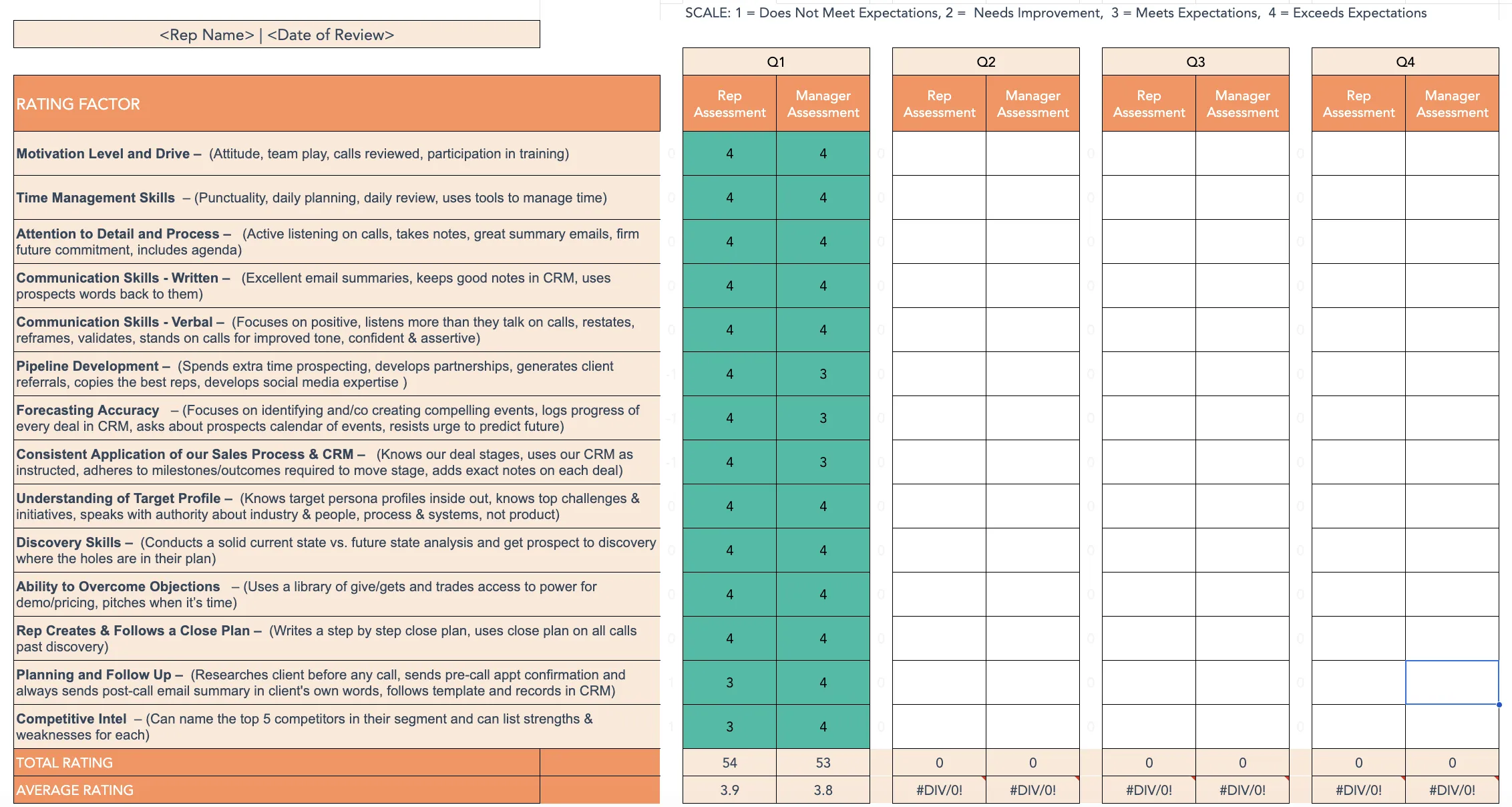
Download our soft skill assessment.
This template gauges the qualitative side of a rep’s performance. It also looks at other essential functions of the job description:
- Motivation
- Time management
- Discovery and forecasting skills
Conducting Specific, Actionable Performance Reviews for Your Team
When you approach a sales performance evaluation from a foundation of trust and intention, you can carry out a productive performance conversation that will align your priorities and goals.
“A sales performance review is just one step. If people approach it as simply, ‘Hey, this is a performance review, we're going to tell you your areas for improvement,’ then that’s not enough. Use your entire sales platform and build a stronger, more in-depth platform rather than just implementing one-off processes,” advises Maximoff.
“Approach it as ‘Hey, here‘s the platform for your growth. Here’s the plan for your growth, and this is what we want you to do for you to be successful. These are the tools we’re giving you and how we're helping you.’”
Use this guide and template to customize your performance review process. Each sales performance review is an opportunity to give feedback, set clear expectations, give actionable advice, and build trust with your team at each step in the process. This can set your team up for lasting sales growth.
The Future of Sales Performance Evaluation
Sales performance evaluation software is rapidly evolving to keep pace with business growth and evolution. AI-powered predictive analytics are helping managers make informed decisions about their team's challenges before they become serious issues. Sales tools like CPQ are evolving, and becoming mobile-friendly for remote sales teams, improving their productivity and effectiveness.
Editor's note: This post was originally published in October 2016 and has been updated for comprehensiveness.

.webp)
.png)
